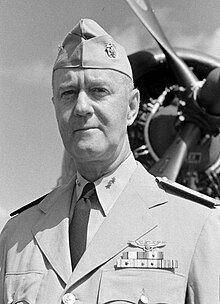Felix Stump
| Felix Stump | |
|---|---|
 |
|
| Born |
December 15, 1894 Parkersburg, West Virginia |
| Died | June 13, 1972 (aged 77) Bethesda Naval Hospital |
| Allegiance |
|
| Service/branch |
|
| Years of service | 1917–1958 |
| Rank |
|
| Commands held |
USS Langley (CV-1) USS Lexington (CV-16) United States Pacific Command |
| Battles/wars |
World War I World War II |
| Awards |
Navy Cross (2) Navy Distinguished Service Medal Army Distinguished Service Medal Legion of Merit (3) Silver Star |
Felix Budwell Stump (December 15, 1894 – June 13, 1972) was an admiral in the United States Navy and Commander, United States Pacific Fleet from July 10, 1953 until July 31, 1958.
Stump was born in Parkersburg, West Virginia, spent his early life there and was appointed to the United States Naval Academy in 1913. He served in the gunboat Yorktown and as navigator aboard the cruiser Cincinnati during World War I in the Atlantic. After the war he served in the pre-dreadnought battleship Alabama. Shortly thereafter Stump attended flight training at the Naval Air Station Pensacola in 1920-1921 followed by postgraduate instruction in Aeronautical Engineering at the Massachusetts Institute of Technology. From 1923 to 1925 he was a Naval Flight Officer in Torpedo Squadron 2 (VT-2) "Doer Birds" of the experimental carrier Langley. He commanded the Cruiser Scouting Wing in 1928-1929 and served on the Staff of Commander Cruisers, Scouting Fleet in 1930-1931. Stump was Commanding Officer of Saratoga's Scout-Bombing Squadron 2 (VSB-2) in 1936-1937. From 1938 to 1939 he served as Navigator of Lexington (CV-2). Promoted to Commander in 1940, he served as Executive Officer of Enterprise.
At the outbreak of World War II, Stump was Commanding Officer of Langley in Manila Bay, Philippines. In January 1942 he was transferred to the Staff of the Commander in Chief, Asiatic Fleet for which he was awarded the U.S. Army's Distinguished Service Medal.
...
Wikipedia
